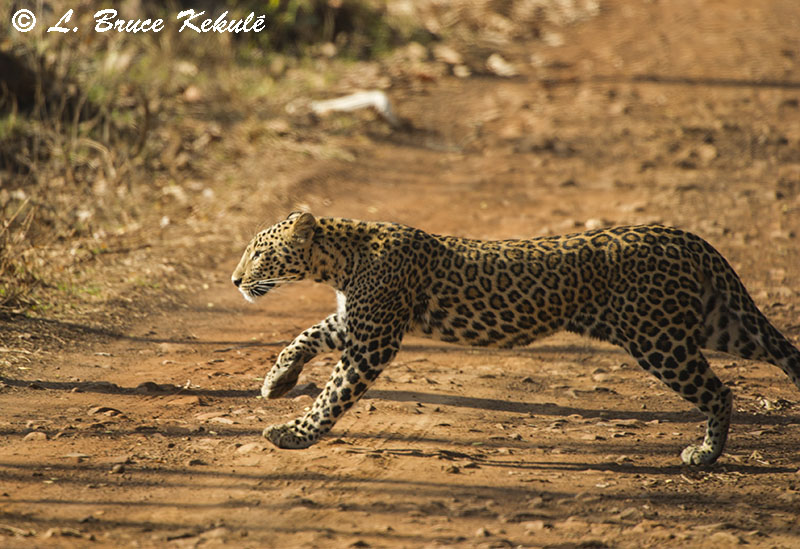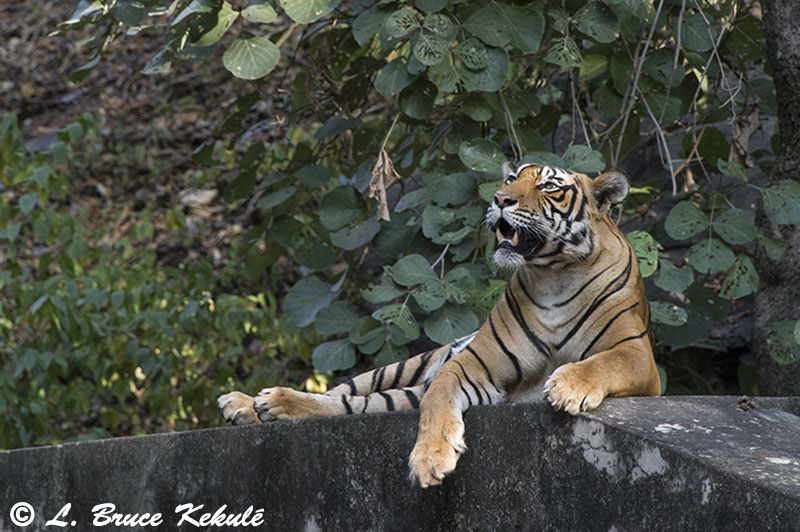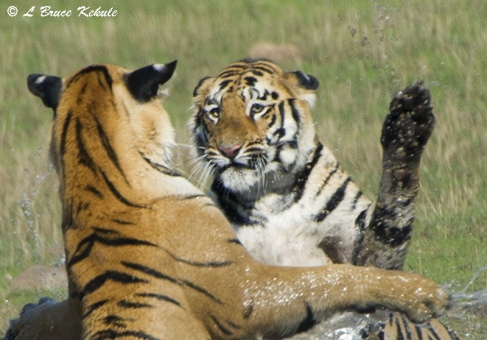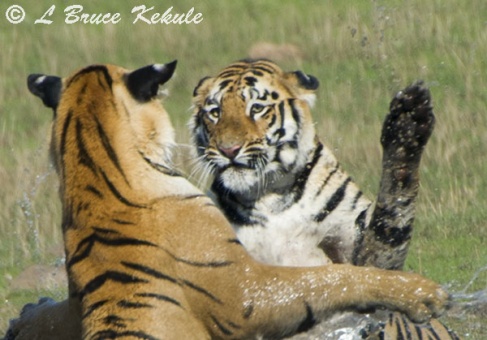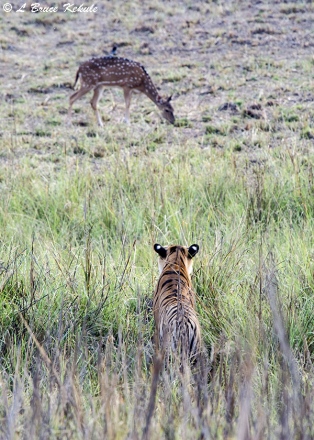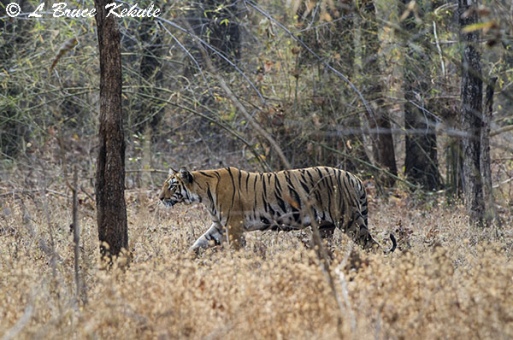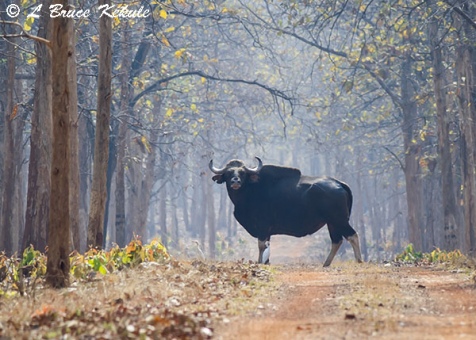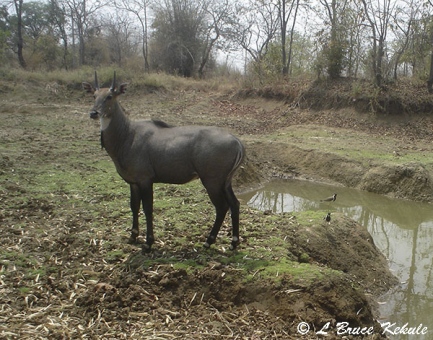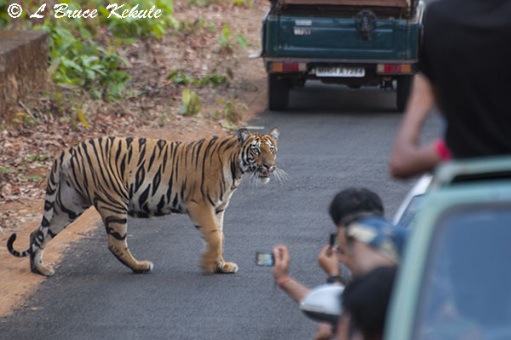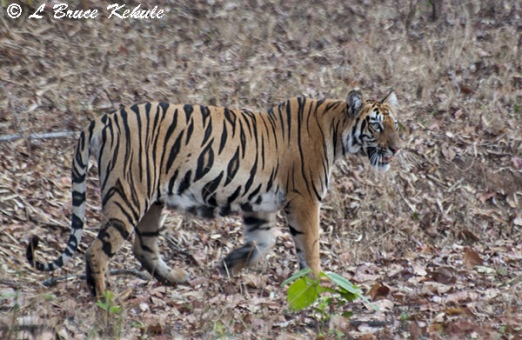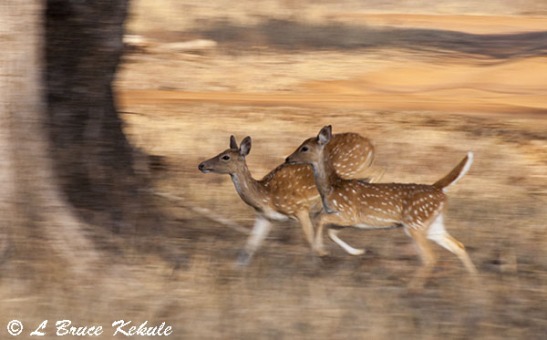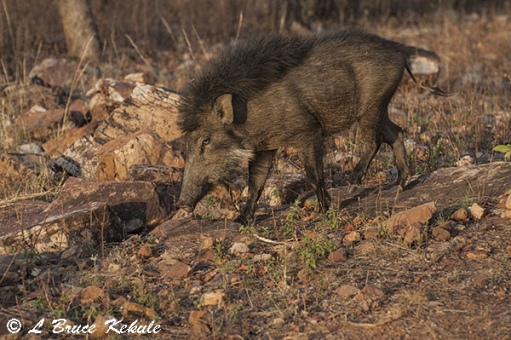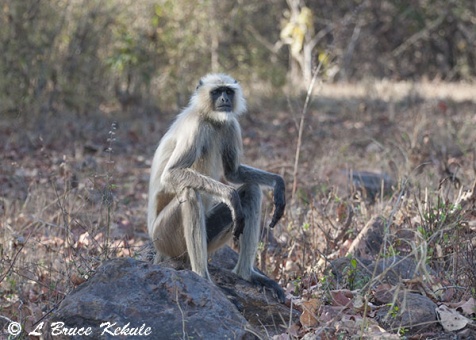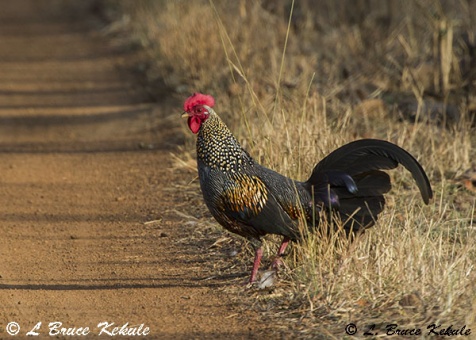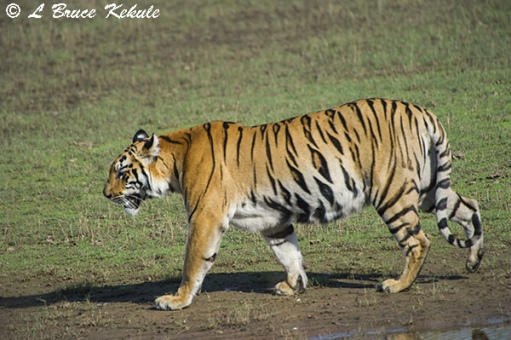Posts Tagged ‘India’
A rare Asian leopard sighting…!
The big cat makes a surprise appearance in India
In 2013, I visited Tadoba Tiger Reserve and national park in the State of Maharashtra, Central India, and spent nine days chasing after tigers with my good friend Luke Stokes from England but who also lives in Thailand like me. We saw seven tigers in nine days that was just awesome for our first trip to the ‘Land of the Tiger’. But the leopard stayed elusive and we did not even get a glimpse of the smaller big cat.
Female posing for me very close to the road – my favorite shot…!
Last year I decided to return to Tadoba once more in March 2015 but had to make bookings way in advance to guarantee a slot. Plans were drawn up, the lodge was selected, dates were locked in and fees were sent. Unfortunately Luke was not able to make this trip with me due to other commitments so I had to go it alone this time. But after a trip to two other Indian tiger reserves in November 2014, I have now become familiar with travel in India that is hectic but has now become almost second nature learning the ropes and system of chaotic India.
Jumping across the road in front of us…!
The flight from New Delhi to Nagpur (the closest city to Tadoba) further south takes about one and half hours and is pretty straightforward. The crowds and security at the airport are tight in Delhi with loads of flights leaving first thing in the morning. I arrived safe and sound to a waiting taxi for the three-hour drive southwest to the lodge just outside the park gate about noon. After some lunch, I rested up and got my cameras ready for the next morning’s safari first thing at 6am.
She is winking at us…!
After a quick coffee and some toast, I jumped into the jeep with a driver and a new acquired friend named Sundran Rajendra, an Indian guy born in Malaysia, brought up in Australia, and now from London. We become immediate friends so at least I had a companion. This was his first trip to India but he was a season traveler having been to Africa many times. We arrived at the gate in five minutes and after paying a small fee for our cameras, moved into the protected area in the dark with a forest guard in tow. The sun began to rise and light filled the forest as we spotted deer and peafowl and other birds just waking up. I was all pumped up but the morning dragged on a bit as we plugged along.
Got her eyes on us now…!
All of a sudden, a leopard was sighted disappearing into the bush. At first I thought that would be it but the driver has worked here for some 35 years and knew what to do. He skillfully moved along the road and stopped ahead of where the leopard might appear. And as sure as the day is long, she moved out of the forest in front of us, hesitated and then jumped across the road disappearing once again. I took a few shots and then we moved once more but this time near a deer kill the mature female had made earlier that morning. She had been chased off by the arrival of several jeeps.
Her final pose before slinking off into the bush – another favorite…!
Once again the driver moved forward and then we waited once again. And like magic, she appeared a third time right in front of us. I did not stop shooting until she left being spooked by too many jeeps arriving. The light became harsh and we had run out of time as the Forest Department has strict rules that must be followed to avoid being fined. Later that morning when the jeeps and everyone had gone, she came back and took the deer kill into the forest for a meal. Sundran and I cheered and jumped up and down celebrating our luck at a rare sighting of an elusive cat. It certainly made our day…! The next morning, we bumped into a female tiger up-close but that is another story to be posted at a later date…Enjoy…!
Happy New Year 2015
Tiger, tiger burning bright…!
A visit to Ranthambore and Bandhavgarh national parks and tiger reserves in India
Sultan the Great of Ranthambore National Park and Tiger Reserve: My favorite shot as he was looking right at me….!
Several months ago, I found someone on Facebook offering a ‘workshop tour’ to some of India’s most famous tiger reserves. At first I was hesitant but after he discounted the trip a $1000 thinking he had assembled a fair sized group, I decided to take the plunge. By that time I had looked at his website and he has some nice images of birds and other animals from around the world. I thought he was a professional. The schedule looked good and we were going to visit three parks over the course of two weeks.
He will be referred to as ‘Mr. Workshop’ from now on. I sent an email to him in Eastern Canada and it was a go. Funds were sent and everything went good for a while. Then the funny email came that he had switched tour companies in India, and some of the schedule and hotels had also been changed. We were now doing only two parks but the overall timeline had not been altered. He also needed another $500 claiming a miscalculation. It then became a worry…! Was this a scam I asked myself…?
I called him and he seemed OK so we were still on. I got a visa to India that was difficult but finally approved by the Indian Embassy in Bangkok a week before departure. I boarded Air India to New Delhi and landed at noon on November 4th just last month. Immigration and customs was pretty straightforward and my luggage arrived in one piece.
‘Ustad’, my first tiger in Ranthambore walking in the forest by the road….!
Mr. Workshop was suppose to meet me at the airport but was no-where to be seen. I opened my laptop looking for the hotel address and got a prepaid taxi (no A/C) for a hell-bent-for-leather horn-blasting ride through the city, and finally arrived only to find out he was at a sister hotel on the far side of town. The thought of scam raced through my brain again…!
So I jumped in another taxi and eventually arrived at the other hotel. He was with a senior lady bird-watching friend from New York and she had gone to Costa Rica with him on a bird tour. So it was only the three of us…! We had dinner, and I hit the sack and crashed after all the crazy mind-blowing travel through Delhi. We were all set to leave first thing the next morning at 6am to beat the traffic out of the city.
After a quick cup of coffee and some breakfast, we departed for the first leg of the tour. We had a nice medium sized car with A/C and a driver with some English skills. It was a six-hour taxi ride south to the hectic town of Sawai Madhopur, close to Ranthambore tiger reserve in northwest India.
‘Ustad’ stopping for some claw scratching….!
We got to the hotel (Ranthambore Regency) at lunchtime and then the news came that only two rooms were available, and I would have to bunk with a stranger. I was not happy but refrained from making any trouble as we had just begun the safari so I reluctantly agreed. I knew it would be uncomfortable and it certainly was going to be a problem down the road but decided to ride it out. He is actually a skim-artist ordering only two rooms from the agent as I found out later…! He took it for granted that it would be OK for him to bunk with me as if we were buddies. I would of course regret that decision.
In the afternoon, we went out on our first ‘game drive’. By then I was all pumped up to see a tiger in the wild. We were in prime big cat habitat. However, the ride to the park entrance was an eye-opener. It is absolute chaos going through any market place in India with people, cars, pollution and rubbish everywhere, plus cows, pigs and camels all over the place, and horn blowing like I have never heard in my entire life.
Even my first trip to India in 2013 was not this bad. I was dumb-founded and did not think I would survive this marketplace again. Close calls and near misses on the road were frequent. We finally got to the gate and entered the reserve. A hat, facemask and sunglasses are a must when traveling through most sections of rural India…!
Ustad close by but very calm around the jeep hordes….!
Day one was absolutely the roughest off-road ride I have had in a long time and I got bounced all over the back seat of a small Suzuki-Maruti jeep (called ‘Gypsy’ in India). We saw loads of prey species like sambar deer, spotted deer, Nilgai (blue bull) antelope plus peafowl, monkeys and many other denizens of the Indian forest but no tiger.
Up at dawn for the first of two drives a day (one in the morning and one in a afternoon). Day two was even rougher as we traveled to another zone up to the top of a mountain. After two days, still no sign of a tiger. I was beginning to wonder if we would see one at all as there were quite a lot of tourists and jeeps about.
But day three was magic as we bumped into a huge male tiger first thing in the morning walking parallel to the road. When you see a tiger in the wild some 20 meters away, you then realize how big these cats really are. We followed him for a while before he disappeared into the bush but reappeared further down the road again for some more shots. It was absolutely great seeing and photographing this iconic apex predator.
Noor’s tiger cub hidden in the bush…!
We then moved to another area where we found loads of jeeps huddled around another tiger named Noor plus two cubs but we could not get close enough for any real good shots as it was packed solid. I did manage to get a couple quick images of a cub and Noor a little later on when she went out hunting leaving the young ones hidden in the grass. We had seen and photographed three tigers in the wild during the morning drive. The afternoon was quiet again. That evening, I had a few beers in celebration.
Day four was the same drill: up at dawn but was less hectic getting into the park as we took another route. Up into the forest we went and ended up in a canyon bumping into Sultan sleeping on a ‘weir’ (concrete check dam). The driver was an expert and got us into a great position directly across from the big cat at eye-level. Mr. Workshop refused to photograph this tiger lying on the concrete saying it was unnatural.
There are stone and concrete structures all over Ranthambore and some date back centuries that have become part of the habitat for so long that tigers use them all the time to rest up and hang out. I began to question his mentality and logic. Come this far after a tiger and complain about the backdrop.
Noor looking after two cubs out hunting in mid-morning….!
I used two cameras on this trip: a Nikon D300s with a Tamron 70-200mm ƒ2.8 lens for my offhand camera, and a Nikon D3s and a Nikon 200-400mm ƒ4 VRII telephoto lens plus a 1.7 converter (for 340-680mm) as my main rig, and used it in conjunction with a Gitzo lightweight ‘Traveler’ graphite tripod and Wemberley gimbal head. I was able to lock onto the sleeping feline without any strain, and be instantly ready for any behavior and movement.
After an hour, Sultan finally woke up and I did not stop shooting. By that time, some 40-50 vehicles had showed up with at least three hundred people behind us and it was complete madness with almost everyone talking at once and jeeps crashing into each other jockeying for position. Everyone wanted to see him. He is probably the most famous tiger in the park now.
On day five, we were lucky to get the same zone again and headed straight back up the canyon. ‘Sultan’ was sleeping close to a water hole and the road, and we got within six meters of him. I went after the close-up head shots and got some really amazing images of this three and half year old mature tiger. He then got up and we moved in further, and he came and flopped down in front of us. It certainly made me very happy. Lady luck was on my side.
Sultan resting on a weir (check dam)….!
In late afternoon that same day as we were traveling by the lake going back to the lodge, we bumped into a large group of trucks and jeeps that had gathered by some tall elephant grass with everyone pointing at something moving in the bush. We moved closer and by sheer luck, Krisha, female tiger stepped out to the left of us. She then moved behind and crossed the road. The driver went into reverse and got us in front of her. I managed to get some very nice head-on shots with a beautiful back-lit scene. Another tiger was in the bag making it five separate sightings. My spirits were high as we returned to the hotel.
However, Mr. Workshop started to get annoying wanting only two things: to photograph tigers and kingfishers. I thought this odd as this trip was meant to be a workshop (as he called it) and I thought we would photograph everything wild but this was not to be the case. His promise that the clients had first priority in the beginning of this tour quickly went out the window. I did not say much and just clammed up deciding to be quiet but the ill feeling continued. I concentrated on getting as many images as possible.
Up from his slumber….!
Day-six and seven was quiet with no more tiger sightings other then some pug marks here and there, plus the usual deer, antelope and birds. It was like we were winding down after all the tiger excitement. We left the hotel that evening and arrived at the train station for the great ‘Indian’ 12-hour train-ride further south that went throughout the night. We were assigned to three sleeper-bunks but I felt extremely uneasy after hearing many stories from friends about train rides in India. But we arrived safe and sound the next morning at Jaibalpur and were met by a designated taxi driver at the train station.
Checking his surroundings….!
The ride to Bandhavgarh National Park and Tiger Reserve took about three and half hours to the hotel (King’s Lodge). During the ride, I decided that I would not be bunking with Mr. Workshop anymore and that he could bunk with his birder friend but that brought out a shriek of terror from her. So I told him to find his own room. It looked like he had been slam-dunked, or an ice bucket put over his head.
Sultan yawning showing his canines…!
We stayed there for four more days and I kept my distance during breakfast and dinner, and we hardly talked at all while in the jeep. He was ticked off that he now had to fork-out cash (mine) for a room. I was totally disgusted with his behavior and I figured no more dialog was the best remedy. He was also extremely rude and showed his arrogant attitude towards anything he did not like or care about.
Unfortunately, we did not see any tigers in Bandhavgarh but there were many pug marks in the dust on the roads telling me the big cats were mainly nocturnal here and would disappear into the bush at first light and come back out at dusk. Poaching pressure was probably the main problem.
Sultan just six-meters away the next morning….!
A natural occurrence also happened last year when a male tiger killed three females to bring them into estrus (breeding) plus all their cubs had been killed. It was a blow to the park but just part of natural selection. After talking to some English wildlife photographers that had been coming since 2008, they said this year was way down on sightings and photographs from previous years.
The only neat thing for me at Bandhavgarh was the fact that I got some great camera trap videos of two ‘jungle cats’ coming to some chicken bait behind my lodge where I set a Bushnell Trophy Cam. These cats have become rare throughout their range and it was neat seeing them. I will be sharing these videos with the naturalists at the hotel so they are aware that these rare cats live there.
Sultan looking ‘straight down the barrel’…My last sighting of this magnificent cat….!
The thing that struck a wrong cord with me about Mr. Workshop was his claim to be a professional photographer. He brought his lens to the jeep in a roll-on bag made for an airline overhead bin to fit a long lens, and he would get dust all over the camera while in the jeep and then just put it back into his bag at the end of every safari. He also would sometimes leave the zip undone and dust poured in during travel around the dirt roads in the park. He complained about the focusing ring being stiff. He also used his shirt to clean his lens.
I brought my cameras to the vehicle on my shoulder and when I got back to the room, would quickly take a wet cloth and wipe the camera and lens down with a moist towel and clean all the nooks and crannies with a toothbrush. I paid special attention to the lens using a blower and special lens brush. My roll-on bag stayed in the room where it was dust-free. I took my cameras back to Thailand without hardly any Indian dust; it is deadly stuff and will damage fine equipment fast…!
Krishna was my fifth sighting in Ranthambore. It was absolutely amazing but a bit stressful due to the overload of tourists…!
Ranthambore National Park and Tiger Reserve: The protected area is situated in Rajasthan State in northwest India and is best known for its historical medieval fort, and is believed to have been built in 944 AD by the Rajputs. The massive battlements dominate the cliffs overlooking the lake where many other structures and temples dot the landscape. But the park is most famous for its tigers. The great tigress named ‘Machli’ who fought off the advances of many males is still going after 19 years and can be seen from time to time but is near the end of her days. And the first male to dominate her in a fight is ‘Sultan’ and he can be found in several zones in the park that is divided into 10 separate areas where tourists and photographers can enter. There are many males and females with cubs and depending on your luck, you may bump into one of these magnificent cats. I saw five tigers over three days during my stay in Ranthambore.
Bandhavgarh National Park and Tiger Reserve: This land of valiant medieval kings was the bastion of the 12th century Kalchuri dynasty – and is situated in a vast verdant forest of Madhya Pradesh in Central India. This scenic region has a rich historical past and civilization that can be traced back some 2,000 years. The protected area is spread over 448 sq. km and was the private hunting grounds of the Maharajas of Rewa. The first ‘white tiger’ was spotted here. Sadly, they no longer can be found in the wild but only in zoos. The famous tigress named Sita made Bandhavgarh famous, as did a male tiger named ‘Charger’ (he made mock chargers on jeeps hence the name). Documentaries produced by National Geographic about tigers and other creatures found here. However, I did not see any tigers in Bandhavgarh but there were loads of pug marks on the roads telling me the big cats were mainly nocturnal and would disappear into the bush at first light and come back out at dusk. Poaching pressure is probably still a problem. Sightings are now quite rare as the tigers have become wary of humans. After talking to some English wildlife photographers that have been coming here since 2008, they said this year was way down on sightings and very photographs of tigers have been taken.
Conclusion: The moral of this story is never trust anyone on Facebook if you don’t know them personally as it could end-up far worse than what I experienced. I was lucky and got my tiger shots plus many other beautiful Indian creatures, but the stress and aggravation of being with someone who was not truthful, arrogant and non-professional was very difficult to cope with. I have learned my lesson and will never ever go on any so-called ‘workshop tours’ found on Facebook. I also know of another individual in Bangkok who scammed some Thai photographers on a ‘tiger tour’ to India off of Facebook…!
If you have a passion to see a tiger in the wild, go on Google and surf the net, or find someone through a national publication like Wildlife Photographer or some other outdoor magazine, or contact the hotels and lodges directly found on the Internet offering tiger tours in India. Many of them are good but it can be hit-and-miss sometimes so try to choose wisely. Check references and follow-up on everything that is not ‘crystal clear’.
Tiger Stripes: Identify individual tigers by their stripes and markings
Nature has provided an interesting concept of identifying individuals by certain patterns like tiger stripes, or even human fingerprints for that matter. There are no two individuals alike so one can recognize the same subject in several photographs if the angle is right. I was able to pick-out the same tiger in two photos taken more than a week apart.
Two tiger cubs sparring in the lake at Tadoba.
As most of you know, I recently went to India and photographed some extremely interesting tigers in Tadoba Andhari Tiger Reserve in central India. It was an exciting trip and I got many photographs of the striped predator including jumping tigers in the lake, and close-up roadside portraits plus many more. The cats here pay no attention to the vehicles most of the time and hence, photos are pretty straightforward with the right equipment, right techniques, right timing and some luck I guess.
Tigers sparring up-close.
On the second morning of my safari, a pair of young tiger cubs entered the shallow lake for some fun and cooling off in the morning sun. I had my Nikon D3s and a 200-400mm VRII lens with a 2X converter for 800mm on a monopod and when the action began, I was ready catching the two in mid-air. This shot is probably one of my best ever photographs as a wildlife photographer.
Tiger cub posing by side of the road
Later in the safari near the end, I caught a tiger posing by the side of the road. This female cub is almost mature and about ready to leave the care of her mother and father. She has been roaming by herself more and more recently.
Tiger posing up-close: Note stripe on left cheek.
In the late afternoon on the next to the last day, a whole bunch of jeeps or ‘Gypsies’ as they are called in India were parked waiting on a sleeping tiger. We could not carry-on because the drivers had plugged-up the road so we also parked and waited.
After awhile, a cub got up from her slumber in the bush on the left and crossed the road in front of us. She walked between the cars and an Indian forest official, and then came over to the right side of our jeep and plopped down with her left front paw resting on a rock. I got many photos and some great portraits with loads of behavior and flashing canines.
Imagine my surprise when going through my photos that I was able to distinguish the tiger by the side of the road was the same animal as in the ‘jumping tigers’ shot. After almost a week, this lovely cat came back to bid me farewell and to show me once again, the magnificent beauty of these striped creatures. Also, on how one can recognize individuals by their distinct markings. A perfect ending to the saga of Tadoba Andhari: Land of the Tiger…!
Tadoba Andhari Tiger Reserve – Nine tigers in seven days
A dream come true: Central India’s top protected area for tiger sightings
Tiger sisters sparring in Tadoba Andhari
Same tigers facing off in the lake.
When the tiger evolved in southern China some two million years ago, the species radiated out, north to Siberia and west to the area around the Caspian Sea. The Himalayan mountain range prevented them from moving south into Nepal and India.
Tiger male by the road early one morning.
From China, it moved through Indochina on down the Malay Peninsula via the now submerged Sunda landbridge to Sumatra, Java and Bali in Indonesia. From there the striped cat moved west through Burma to the Indian sub-continent. The Bengal tiger is the second largest after the Siberian species.
A breeding pair in the northern section.
A century ago, there were more than 100,000 tigers throughout their range and India had about 40,000 at that time. Now, it is estimated that maybe 3,200 of these magnificent predators are left in the world with some 2,000 thriving in India and Nepal.
Tiger cub stalking a spotted deer by the lake.
The Indochinese species is just hanging on with about 250 in Thailand and another 250 in Malaysia. Sumatra has about 400 tigers. The Chinese, Caspian, Balinese and Javan tigers are all now extinct, a sad fact!
Tiger cub in the afternoon.
A internet search revealed that there is one protected area that stands above all the others for tiger sightings in India. Tadoba Andhari Tiger Reserve for some time now has been one of India’s most famous for the ease of seeing and photographing the big cat up-close and personal at times. Tadoba was declared a tiger reserve in 1933 and a National Park in 1955.
Bull gaur on the road in the buffer zone.
A buffer zone was recently added and the total area is now 1,700 sq. kilometers. Many other animals are found here including leopard, sloth bear, wild dog, gaur, sambar, chital (spotted deer), nilgai (blue bull), four-horned antelope, muntjac, mugger crocodile plus loads of smaller mammals and birds including the spectacular Indian blue peafowl and the beautiful grey jungle fowl.
Chital stag on the run being chased by wild dogs.
Overlooked by tourist until recently, this forest is situated in central India in the Maharashtra state about 700 kilometers north of Hyderabad. It is split into two parts, north and south. Only 20 percent is now open to the public, and the other 80 percent off-limits to everyone except forest officials after a Supreme Court decision last year in September. The court wanted to close all of the tiger reserves but an outcry from the people was heard and many parks now have only limited access.
Sloth bear near the lake.
Arrangements to travel like visas, air tickets and lodge bookings were arranged and I took off on Thai Airways to Hyderabad on April 4th, arriving at 1:00pm and then undertook a nine-hour taxi ride to the sanctuary. It was scary, to say the least after we got lost in rural India for a short while. The taxi driver finally got back on track and we arrived at the sanctuary at noon.
Wild dogs resting in an evergreen stream bed.
Lunch was served at the Tiger Trails Jungle Lodge situated five-minutes from the front gate of the reserve that would be my home for the next nine days. The food, lodging and service is excellent, and well worth the expense to get there. The closest city is Nagpur only two hours by road and is serviced by daily flights.
Nilgai (Blue Bull) antelope camera trapped near the Tiger Trail Jungle Lodge.
In the afternoon at 3pm, I made my first safari in a ‘Maruti’ jeep (Suzuki) with a naturalist from the lodge, a tour guide and a driver. We got a glimpse of a tiger as the sun was going down. The next day at daybreak, we went south to a lake in the interior. It was reported that four female tiger cubs, and a mother and father were sighted almost everyday in the area.
Tiger cub on the road among the tourists.
We arrived, as did many other jeeps, and we sat in the cool morning waiting for the family to arrive. At 9:30am, the first cub came out of the deep forest across from us and walked past submerging itself in the water to cool off. Then another cub arrived from the other side and they both joined up, and began sparring and facing off. I was ready with my Nikon D3s and a 200-400mm VR lens on a monopod catching the pair in mid-air as seen in the lead photo.
Tiger cub checking out a Tadoba forest official.
The next morning after only five minutes from the gate, we bumped into a male tiger 50 meters from the road out in the open grassland sleeping. Shortly thereafter, he woke up and posed for me. Then we moved to the lake and a cub walked past our jeep about three meters away. We saw tiger everyday except for Tuesday when the park is closed. I however, got a huge gaur bull in the buffer zone next to Tadoba shown here.
Tiger cub emerging after a late afternoon nap.
In the northern section, there is a breeding pair of tigers also shown in the story. They should produce a nice litter that will be an attraction for this place sometime late this year. The four cubs at the lake should disperse very soon. There are many other mature tigers and cubs throughout the sanctuary and at last count, there are about 75 individuals in the park and buffer zone.
Tadoba’s rock pantheons along the road in the tiger reserve.
Tadoba has a rich history that goes back to the 17th century. Once upon a time, dynasties of Gond Kings ruled this part of the Deccan plateau. When the kings traveled through the area, the message of his arrival would be transmitted by an engineering feat. There were rock pantheons erected every hundred yards, which had perfectly aligned tops. Over these were drawn inter-connected ropes which rung a bell at the end. The soldier just tugged on the rope and the bell would ring 50 kilometers away, signaling the approach of his majesty. Many of these rock pillars are still standing seen in the story.
Chital female posing near the road.
Like most things, my safari finally came to a close. I left the lodge at mid-day and dreaded the long taxi ride back to Hyderabad but we eventually arrived at the airport at 9pm. The driver pulled through and got me there in one piece. Then it was a bit of a hassle getting through customs and immigration as security is tight but once through, I had a chance to relax and get something to eat. I boarded the plane for the short three and half hour flight and before I knew it, was home back in Bangkok.
Chital on the run being chased by wild dogs.
India has many problems with poachers and encroachment. Two national parks, Sariska and Panna, had all their tigers poached in a short period of time. As long as there is a market for wildlife parts, the trade in these will continue to carry-on with impunity. However, the government has already reintroduced tigers to these parks but it could take a long time for them to recover fully.
Young sambar stag with tiger claw marks.
Tiger skin, bones, organs and even whiskers are sold in a million-dollar black market to Chinese, Vietnamese and Tibetan buyers. It is heartbreaking that barbaric wildlife traffickers have the audacity to trade the tiger and other animals in bits and pieces, by the gram and kilo.
A mature sambar stag with some serious battle scars.
If you want to see a tiger in the wild, head to India which offers the best opportunities to view the striped predator. There are many tiger reserves and depending on luck, one may bump into one. But Tadoba is at the top of the list for sightings. I definitely will be heading back to this amazing place and hopefully in the near future, more areas will be opened up.
A wild pib in Tadoba.
Unfortunately, Thailand could never offer this wildlife spectacle as the tiger and other Asian creatures have been persecuted for so long making these animals extremely wary which has made sightings rare. But it is still possible in places like Thap Lan and Pang Sida in the northeast, Kaeng Krachan and Kui Buri in the southwest and over in the western protected areas like Sai Yok and Erawan national parks to bump into one.
A gaur in bamboo not far from the road.
I have been working in Huai Kha Khaeng Wildlife Sanctuary for more than 15 years, Thailand greatest tiger sanctuary, and have only seen and photographed one male tiger. However, there are many tigers in this forest (about 75) as witnessed by loads of camera trap photos that have come forth from researchers and wildlife photographers. Needless to say, we need to look after this and other places that have tigers so that these magnificent creatures may continue to thrive into the foreseeable future!
Additional photos from the safari
Langur monkeys are common by the road
A langur posing close to the jeep.
Indian blue peafowl in the bamboo.
Wild boar on the run.
Indian grey mongoose drinking at a waterhole.
Indian grey jungle fowl by the road.
Grey jungle fowl in early morning.
The tigers of Tadoba
India: Land of the tiger
Two tiger cubs sparring in the lake at Tadoba.
After 10 amazing days in the sub-continent of India, I returned to Thailand with a load of tiger photographs. A few shots are some of my best work as a wildlife photographer shown here. The opportunity to see and catch this illusive carnivore presented itself. However, some parts of the trip were extremely dangerous and stressful including a nine-hour taxi ride to and from Tadoba Tiger Reserve in the State of Maharashtra some 700 kilometers north from Hyderabad. It was hectic to say the least.
Only 20% of the sanctuary is now open with 80% off-limits but it is truly India’s top protected area for tiger sightings. I saw nine tigers in seven days. It was very exciting seeing and photographing the big cat. This is just part of the selection of shots I got. It shows a truly magnificent ecosystem where predators thrive because prey species are found in abundance. I will be doing an extensive post a little bit later.
The same pair facing-off.
Tiger cub in the lake.
Tiger male walking by the lake.
Tiger female by the lake.
Tiger cub about three meters away.
Old ‘One Eye’, father of the cubs near the road.
Tiger cub posing by side of the road
Tiger cub about to yawn
Tiger cub showing its fangs
Needless to say, it was an experience now etched in memory. All shots were taken with a Nikon D3s and 200-400mm VRII lens and mono-pod except for the tiger close-up, and that was with a Nikon D90 and a 70-300mm VR lens. I was always ready from close to distant. Enjoy….!
A neelgai (blue bull), a even-toed ungulate found in most Indian protected areas. Prime tiger prey species.



